Fault Ride-Through Operation Analysis of Doubly Fed Induction Generator-Based Wind Energy Conversion Systems: A Comparative Review
Abstract
1. Introduction
- The technical specifications and restrictions in various nations’ international grid-code requirements for the WEC system are summarized.
- The present study also includes a precise mathematical model of the DFIG-based WEC system.
- Different FRT strategies with detailed illustrations and explanations at different operations are noted, presenting the benefits and drawbacks of implementing them to improve the transient response of wind turbines based on DFIG.
- The paper also presents a comparative study of different FRT schemes and validates their ability during transient operation.
- Real-time simulator (RTS) and MATLAB/Simulink application results are also used to assess and investigate a case study.
2. Grid Code Requirements for WEC Systems
3. Modeling of DFIG-Based WEC Systems
3.1. Aerodynamic Modelling of Wind Turbines
3.2. DFIG Modelling
4. FRT Techniques for Improving DFIG-WEC System Transient Stability
- Protection devices during transient conditions.
- Injection of reactive power in transient conditions.
- Suitable control system for transient and steady state conditions.
4.1. FRT Schemes Overview
4.2. External Retrofit-Based FRT Techniques for DFIG
Protection Circuit-Oriented FRT Techniques
- (a)
- Crowbar Circuit
- (b)
- Crowbar series RL-equipped circuit
- (c)
- Chopper technique for DC links
- (d)
- Series dynamic braking resistor (SDBR) control scheme
- (e)
- Modulated series DBR (MSDBR)
- (f)
- Fault CLs
- (g)
- Energy Storage Strategies (ESS)
- (h)
- Series Grid-Side Converter
4.3. Reactive Power-Injecting Devices-Oriented FRT Strategies
- (a)
- Dynamic Voltage Restorer
- Bypass mode: This mode enables the DVR to be bypassed mechanically or electronically in the case of severe load currents or down-stream short circuits, while the DVR does not inject voltage to achieve better voltage efficiency.
- Standby mode: This mode has a rated voltage, and the DVR is ready to handle a voltage drop. Throughout the standby mode, the DVR may perform secondary tasks.
- Active mode: After detecting a voltage fall, the DVR injects the lost voltage in this mode.
- (b)
- Static VAR Compensator (SVC)
- (c)
- Static synchronous compensator (STATCOM)
- (d)
- Magnetic Energy Recovery Switch (MERS)
- (e)
- Hybrid compensation
4.4. Future Research Ideas on WEC System Transient Stability Employing External Retrofitting
4.5. Internal Retrofit-Based FRT Techniques for DFIGs
- (a)
- Feed-forward and transient current control (FFTC)
- (b)
- Model predictive control
- (c)
- Sliding mode control
- (d)
- Fuzzy logic controller
- (e)
- Other advanced control
4.6. Future Research Ideas on WEC System Transient Stability Employing Control Mechanisms
5. Simulation Study
5.1. DFIG Performance Analysis with the Absence of Protection
5.2. DFIG Performance Analysis with Crowbar Protection
5.3. DFIG Performance Analysis with Rotor Series Dynamic Breaking Resistance (RSDBR) Protection
6. RTS Results Discussion
7. Comparison of the Performance of Simulated Techniques
8. Conclusions and Recommendations
- Efficient FRT performance can be obtained with traditional crowbar guarding, but delayed disengagement results in grid reactive power absorption. The future direction is to utilize the crowbar for FRT methods, which incorporates a combinational approach with batteries and other modification approaches of RSPEC in order to deliver greater FRT capabilities.
- The time needed to disconnect and restore the converter was greater with the DC link chopper method than it was with the crowbar control, as the chopper did not genuinely assist electric machines in post-fault demagnetization. The chopper technique performs significantly weaker than the crowbar technique.
- As of recently, FCL-based configurations have been vastly enhanced. In the comparative analysis, the resistive type FCL situated on the side of the stator operates efficiently, owing to its ability to compensate for voltage sag, the surplus active power consumed, and the increase in the control of RSPEC. However, these circuits need certain advanced control approaches for assessing the parametric uncertainties of a nonlinear power network. The future direction of these FRT systems is the optimized parameter selection for current restrictions. An adaptive technique should be used for the evaluation of increased FRT capabilities.
- Battery storage techniques only offer active power adjustment by minimizing DC link voltage variations. They are incapable of providing reactive power adjustment. So, the future trends for FRT solutions based on ESS will be to use a combinational approach to improve both real and reactive power.
- FRT can be provided solely with the use of DVR, without the need for any other protective measures. The low-rated DVR-based configuration is cost-effective and capable of circumventing the requirement of complex control techniques while improving the overall reactive power support throughout the FRT in the DFIG.
- The dynamical performance of wind turbines in a power system can be strengthened using STATCOM. In comparison to STATCOM with SVC, STATCOM provides superior voltage characteristics, and it can provide greater reactive power adjustment when there are severe faults. However, it requires a cost-effective solution.
- The active approaches used in modern WEC systems can be used efficiently on the basis of improved control methods in RSPEC or GSPEC controllers. Especially in comparison with passive approaches, these active approaches lower external hardware costs.
- Modern controllers with adaptive techniques reduce the complexity of the vector loop modification and give a dynamic response that is both rapid and resilient. These controllers have to be capable of meeting the requirements of a weak grid through the LVRT improvement of DFIG-WTs.
Author Contributions
Funding
Institutional Review Board Statement
Informed Consent Statement
Data Availability Statement
Acknowledgments
Conflicts of Interest
Nomenclature
| Wind speed (m/s) | ids: iqs | d–q components of the stator current | |
| R | Radius of the rotor in meters | ∅ds,∅qs | d–q components of the stator flux |
| Air density in kg/m3 | vdr, vqr | d–q components of the rotor voltage | |
| Cp (λ, β) | Power coefficient | idr, iqr | d–q components of the rotor current |
| Tip speed ratio of the turbine blade | ∅dr, ∅qr | d–q components of the rotor flux | |
| Pitch angle in degrees | Rs, Rr | Stator and rotor resistance | |
| Gamma function | Ls, Lr | Stator and rotor inductance | |
| Mechanical active power in watts | M | Mutual inductance | |
| Tm | Mechanical torque | Tem | Electrical torque |
| nr | Rotational speed of the turbine rotor | s | Slip |
| ωs | Synchronous electrical speed | Pole pairs | |
| ωre | Rotor’s electrical speed | Ps | Stator real power. |
| vds, vqs | d–q components of the stator voltage | Qs | Stator reactive power. |
References
- Global Wind Report 2021—Global Wind Energy Council. Available online: https://gwec.net/global-wind-report-2021/ (accessed on 18 May 2022).
- Bhowmik, S.; Spee, R.; Enslin, J. Performance optimization for doubly fed wind power generation systems. IEEE Trans. Ind. Appl. 1999, 35, 949–958. [Google Scholar] [CrossRef]
- Carrasco, J.M.; Franquelo, L.G.; Bialasiewicz, J.T.; Galvan, E.; PortilloGuisado, R.; Prats, M.A.M.; Leon, J.I.; Moreno-Alfonso, N. Power-electronic systems for the grid integration of renewable energy sources: A survey. IEEE Trans. Ind. Electron. 2004, 53, 1002–1016. [Google Scholar] [CrossRef]
- Ansari, A.A.; Dyanamina, G. Comparative analysis of controlling methods for doubly fed induction generator based wind energy system. Lect. Notes Electr. Eng. 2022, 852, 493–507. [Google Scholar] [CrossRef]
- Ekanayake, J.; Jenkins, N. Comparison of the response of doubly fed and fixed-speed induction generator wind turbines to changes in network frequency. IEEE Trans. Energy Convers. 2004, 19, 800–802. [Google Scholar] [CrossRef]
- Yaramasu, V.; Wu, B.; Sen, P.C.; Kouro, S.; Narimani, M. High-power wind energy conversion systems: State-of-the-art and emerging technologies. Proc. IEEE 2015, 103, 740–788. [Google Scholar] [CrossRef]
- Pannell, G.; Atkinson, D.J.; Zahawi, B. Minimum-threshold crowbar for a fault-ride-through grid-code-compliant DFIG wind turbine. IEEE Trans. Energy Convers. 2010, 25, 750–759. [Google Scholar] [CrossRef]
- Pannell, G.; Zahawi, B.; Atkinson, D.J.; Missailidis, P. Evaluation of the performance of a DC-link brake chopper as a DFIG low-voltage fault-ride-through device. IEEE Trans. Energy Convers. 2013, 28, 535–542. [Google Scholar] [CrossRef]
- Huchel, L.; El Moursi, M.S.; Zeineldin, H.H. A parallel capacitor control strategy for enhanced FRT capability of DFIG. IEEE Trans. Sustain. Energy 2014, 6, 303–312. [Google Scholar] [CrossRef]
- Guo, W.; Xiao, L.; Dai, S.; Xu, X.; Li, Y.; Wang, Y. Evaluation of the performance of BTFCLs for enhancing LVRT capability of DFIG. IEEE Trans. Power Electron. 2014, 30, 3623–3637. [Google Scholar] [CrossRef]
- Ibrahim, A.O.; Nguyen, T.H.; Lee, D.-C.; Kim, S.-C. A fault ride-through technique of DFIG wind turbine systems using dynamic voltage restorers. IEEE Trans. Energy Convers. 2011, 26, 871–882. [Google Scholar] [CrossRef]
- Zhang, S.; Tseng, K.-J.; Choi, S.S.; Nguyen, T.D.; Yao, D.L. Advanced control of series voltage compensation to enhance wind turbine ride through. IEEE Trans. Power Electron. 2011, 27, 763–772. [Google Scholar] [CrossRef]
- Amaris, H.; Alonso, M. Coordinated reactive power management in power networks with wind turbines and FACTS devices. Energy Convers. Manag. 2011, 52, 2575–2586. [Google Scholar] [CrossRef]
- Yuan, X. Overview of problems in large-scale wind integrations. J. Mod. Power Syst. Clean Energy 2013, 18, 22–25. [Google Scholar] [CrossRef]
- Flannery, P.S.; Venkataramanan, G. A fault tolerant doubly fed induction generator wind turbine using a parallel grid side rectifier and series grid side converter. IEEE Trans. Power Electron. 2008, 23, 1126–1135. [Google Scholar] [CrossRef]
- Mahela, O.P.; Gupta, N.; Khosravy, M.; Patel, N. Comprehensive Overview of Low Voltage Ride through Methods of Grid Integrated Wind Generator. IEEE Access 2019, 7, 99299–99326. [Google Scholar] [CrossRef]
- Tsili, M.; Papathanassiou, S. A review of grid code technical requirements for wind farms. IET Renew. Power Gener. 2009, 3, 308–332. [Google Scholar] [CrossRef]
- Attya, A.; Domínguez-García, J.L.; Anaya-Lara, O. A review on frequency support provision by wind power plants: Current and future challenges. Renew. Sustain. Energy Rev. 2018, 81, 2071–2087. [Google Scholar] [CrossRef]
- Abad, G.; López, J.; Rodríguez, M.A.; Marroyo, L.; Iwanski, G. Dynamic modeling of the doubly fed induction machine. Doubly Fed Induction Mach. 2011, 209–239. [Google Scholar] [CrossRef]
- Justo, J.J.; Mwasilu, F.; Jung, J.-W. Doubly-fed induction generator based wind turbines: A comprehensive review of fault ride-through strategies. Renew. Sustain. Energy Rev. 2015, 45, 447–467. [Google Scholar] [CrossRef]
- Kayikci, M.; Milanovic, J.V. Assessing transient response of DFIG-based wind plants—The influence of model simplifications and parameters. IEEE Trans. Power Syst. 2008, 23, 545–554. [Google Scholar] [CrossRef]
- Mwasilu, F.; Jung, J.-W.; Ro, K.-S.; Justo, J. Improvement of dynamic performance of doubly fed induction generator-based wind turbine power system under an unbalanced grid voltage condition. IET Renew. Power Gener. 2012, 6, 424–434. [Google Scholar] [CrossRef]
- Lima, F.K.A.; Luna, A.; Rodriguez, P.; Watanabe, E.H.; Blaabjerg, F. Rotor voltage dynamics in the doubly fed induction generator during grid faults. IEEE Trans. Power Electron. 2009, 25, 118–130. [Google Scholar] [CrossRef]
- Rahimi, M.; Azizi, A. Transient Behavior Representation, Contribution to Fault Current Assessment, and Transient Response Improvement in DFIG-Based Wind Turbines Assisted with Crowbar Hardware. Int. Trans. Electr. Energy Syst. 2019, 29, e2698. [Google Scholar] [CrossRef]
- Haidar, A.M.A.; Muttaqi, K.M.; Hagh, M.T. A Coordinated control approach for DC link and rotor crowbars to improve fault ride-through of DFIG-based wind turbine. IEEE Trans. Ind. Appl. 2017, 53, 4073–4086. [Google Scholar] [CrossRef]
- Din, Z.; Zhang, J.; Zhu, Y.; Xu, Z.; El-Naggar, A. Impact of grid impedance on LVRT performance of DFIG system with rotor crowbar technology. IEEE Access 2019, 7, 127999–128008. [Google Scholar] [CrossRef]
- Justo, J.; Bansal, R. Parallel R-L configuration crowbar with series R-L circuit protection for LVRT strategy of DFIG under transient-state. Electr. Power Syst. Res. 2018, 154, 299–310. [Google Scholar] [CrossRef]
- Shi, J.; Tang, Y.; Xia, Y.; Ren, L.; Li, J. SMES based excitation system for doubly-fed induction generator in wind power application. IEEE Trans. Appl. Supercond. 2011, 21, 1105–1108. [Google Scholar] [CrossRef]
- Guo, W.; Xiao, L.; Dai, S. Enhancing low-voltage ride-through capability and smoothing output power of DFIG with a superconducting fault-current limiter–magnetic energy storage system. IEEE Trans. Energy Convers. 2012, 27, 277–295. [Google Scholar] [CrossRef]
- Naderi, S.B.; Negnevitsky, M.; Muttaqi, K.M. A Modified DC chopper for limiting the fault current and controlling the DC-link voltage to enhance fault ride-through capability of doubly-fed induction-generator-based wind turbine. IEEE Trans. Ind. Appl. 2018, 55, 2021–2032. [Google Scholar] [CrossRef]
- Yang, J.; Fletcher, J.E.; O’Reilly, J. A series-dynamic-resistor-based converter protection scheme for doubly-fed induction generator during various fault conditions. IEEE Trans. Energy Convers. 2010, 25, 422–432. [Google Scholar] [CrossRef]
- Huang, J.; Zhang, L.; Sang, S.; Xue, X.; Zhang, X.; Sun, T.; Wu, W.; Gao, N. Optimized series dynamic braking resistor for LVRT of doubly-fed induction generator with uncertain fault scenarios. IEEE Access 2022, 10, 22533–22546. [Google Scholar] [CrossRef]
- Huang, P.-H.; El Moursi, M.S.; Hasen, S.A. Novel fault ride-through scheme and control strategy for doubly fed induction generator-based wind turbine. IEEE Trans. Energy Convers. 2014, 30, 635–645. [Google Scholar] [CrossRef]
- Guo, W.; Xiao, L.; Dai, S.; Li, Y.; Xu, X.; Zhou, W.; Li, L. LVRT capability enhancement of DFIG with switch-type fault current limiter. IEEE Trans. Ind. Electron. 2014, 62, 332–342. [Google Scholar] [CrossRef]
- Naderi, S.B.; Davari, P.; Zhou, D.; Negnevitsky, M.; Blaabjerg, F. A review on fault current limiting devices to enhance the fault ride-through capability of the doubly-fed induction generator based wind turbine. Appl. Sci. 2018, 8, 2059. [Google Scholar] [CrossRef]
- Puchalapalli, S.; Singh, B. A novel control scheme for wind turbine driven DFIG interfaced to utility grid. IEEE Trans. Ind. Appl. 2020, 56, 2925–2937. [Google Scholar] [CrossRef]
- Qu, L.; Qiao, W. Constant power control of DFIG wind turbines with supercapacitor energy storage. IEEE Trans. Ind. Appl. 2011, 47, 359–367. [Google Scholar] [CrossRef]
- Jayasinghe, S.D.G.; Vilathgamuwa, D.M. Flying supercapacitors as power smoothing elements in wind generation. IEEE Trans. Ind. Electron. 2012, 60, 2909–2918. [Google Scholar] [CrossRef]
- Shen, Y.W.; Ke, D.P.; Qiao, W.; Sun, Y.Z.; Kirschen, D.S.; Wei, C. Transient reconfiguration and co-ordinated control for power converters to enhance the LVRT of a DFIG wind turbine with an energy storage device. IEEE Trans. Energy Convers. 2015, 30, 1679–1690. [Google Scholar] [CrossRef]
- Chen, X.; Yan, L.; Zhou, X.; Sun, H. A novel DVR-ESS-embedded wind-energy conversion system. IEEE Trans. Sustain. Energy 2018, 9, 1265–1274. Available online: https://ieeexplore.ieee.org/document/8170301/ (accessed on 19 May 2022). [CrossRef]
- Gontijo, G.; Tricarico, T.; Krejci, D.; França, B.; Aredes, M. A novel stator voltage distortion and unbalance compensation of a DFIG with series grid side converter using adaptive resonant controllers. In Proceedings of the 2017 Brazilian Power Electronics Conference (COBEP), Juiz de Fora, Brazil, 19–22 November 2017; pp. 1–6. [Google Scholar]
- Omar, S.; Helal, A.; Elarabawy, I. Stator voltage sensorless DFIG with low voltage ride-through capability using series and parallel grid side converters. In Proceedings of the 2016 7th International Renewable Energy Congress (IREC), Hammamet, Tunisia, 22–24 March 2016; pp. 1–6. [Google Scholar] [CrossRef]
- Meyer, C.; De Doncker, R.W.; Li, Y.W.; Blaabjerg, F. Optimized control strategy for a medium-voltage DVR—Theoretical investigations and experimental results. IEEE Trans. Power Electron. 2008, 23, 2746–2754. [Google Scholar] [CrossRef]
- Nielsen, J.; Blaabjerg, F. A detailed comparison of system topologies for dynamic voltage restorers. IEEE Trans. Ind. Appl. 2005, 41, 1272–1280. [Google Scholar] [CrossRef]
- Li, Y.W.; Blaabjerg, F.; Vilathgamuwa, D.M.; Loh, P.C. Design and comparison of high performance stationary-frame controllers for DVR implementation. IEEE Trans. Power Electron. 2007, 22, 602–612. [Google Scholar] [CrossRef]
- Marafao, F.; Colon, D.; Jardini, J.; Komatsu, W.; Matakas, L.; Galassi, M.; Ahn, S.; Bormio, E.; Camargo, J.; Monteiro, T.; et al. Multiloop controller and reference generator for a Dynamic Voltage Restorer implementation. In Proceedings of the ICHQP 2008: 13th International Conference on Harmonics and Quality of Power, Wollongong, NSW, Australia, 28 September–1 October 2008; pp. 1–6. [Google Scholar] [CrossRef]
- Wessels, C.; Gebhardt, F.; Fuchs, F.W. Fault ride-through of a dfig wind turbine using a dynamic voltage restorer during symmetrical and asymmetrical grid faults. IEEE Trans. Power Electron. 2010, 26, 807–815. [Google Scholar] [CrossRef]
- Falehi, A.D.; Rafiee, M. Maximum efficiency of wind energy using novel dynamic voltage restorer for DFIG based wind turbine. Energy Rep. 2018, 4, 308–322. [Google Scholar] [CrossRef]
- Latif, S.; Savier, J. Design and implementation of DVR as fault current limiter in DFIG during grid faults. Int. J. Eng. Syst. Model. Simul. 2021, 12, 38–53. [Google Scholar] [CrossRef]
- Singh, B. Introduction to FACTS controllers in wind power farms: A technological review. Int. J. Adv. Renew. Energy Res. (IJARER) 2012, 1. [Google Scholar]
- Mithulananthan, N.; Canizares, C.; Reeve, J.; Rogers, G. Comparison of PSS, SVC, and STATCOM controllers for damping power system oscillations. IEEE Trans. Power Syst. 2003, 18, 786–792. [Google Scholar] [CrossRef]
- Hemeida, M.G.; Hussien, H.R.; Wahab, M.A.A. Stabilization of a wind farm using static VAR compensators (SVC) based fuzzy logic controller. Adv. Energy Power 2015, 3, 61–74. [Google Scholar] [CrossRef]
- Molinas, M.; Suul, J.A.; Undeland, T. Low voltage ride through of wind farms with cage generators: STATCOM versus SVC. IEEE Trans. Power Electron. 2008, 23, 1104–1117. [Google Scholar] [CrossRef]
- Muyeen, S.M. A combined approach of using an SDBR and a STATCOM to enhance the stability of a wind farm. IEEE Syst. J. 2015, 9, 922–932. [Google Scholar] [CrossRef]
- Narushima, J.; Inoue, K.; Takaku, T.; Isobe, T.; Kitahara, T.; Shimada, R. Application of magnetic energy recovery switch for power factor correction. In Proceedings of the IPEC 2005: The 7th International Power Engineering Conference, Marina Mandarin Hotel, Singapore, 29 November–2 December 2005; pp. 737–743. [Google Scholar]
- Wiik, J.A.; Wijaya, F.D.; Shimada, R. Characteristics of the magnetic energy recovery switch (MERS) as a series FACTS controller. IEEE Trans. Power Deliv. 2009, 24, 828–836. [Google Scholar] [CrossRef]
- Alharbi, Y.M.; Abu-Siada, A. Application of UPFC to Improve the Low-Voltage-Ride-Through Capability of DFIG. 2015, pp. 665–668. Available online: https://ieeexplore.ieee.org/document/7281548/ (accessed on 20 May 2022).
- Choopani, M.; Hosseinian, S.H.; Vahidi, B. New transient stability and LVRT improvement of multi-VSG grids using the frequency of the center of inertia. IEEE Trans. Power Syst. 2020, 35, 527–538. [Google Scholar] [CrossRef]
- Liang, J.; Howard, D.F.; Restrepo, J.A.; Harley, R.G. Feedforward transient compensation control for DFIG wind turbines during both balanced and unbalanced grid disturbances. IEEE Trans. Ind. Appl. 2013, 49, 1452–1463. [Google Scholar] [CrossRef]
- Abdelrahem, M.; Mobarak, M.H.; Kennel, R. Model predictive control for low-voltage ride through capability enhancement of DFIGs in variable-speed wind turbine systems. In Proceedings of the 9th International Conference on Electrical and Computer Engineering, ICECE, Dhaka, Bangladesh, 20–22 December 2016; pp. 70–73. [Google Scholar] [CrossRef]
- Kou, P.; Liang, D.; Li, J.; Gao, L.; Ze, Q. Finite-control-set model predictive control for DFIG wind turbines. IEEE Trans. Autom. Sci. Eng. 2018, 15, 1004–1013. [Google Scholar] [CrossRef]
- Rafiee, Z.; Heydari, R.; Rafiee, M.; Aghamohammadi, M.R.; Rodriguez, J.; Blaabjerg, F. Adaptive model predictive control of DFIG-based wind farm: A model-free control approach. In Proceedings of the 2020 IEEE 21st Workshop on Control and Modeling for Power Electronics (COMPEL 2020), Aalborg, Denmark, 9–12 November 2020; pp. 1–6. [Google Scholar] [CrossRef]
- Mossa, M.A.; Do, T.D.; Al-Sumaiti, A.S.; Quynh, N.V.; Diab, A.A.Z. Effective model predictive voltage control for a sensorless doubly fed induction generator. IEEE Can. J. Electr. Comput. Eng. 2021, 44, 50–64. [Google Scholar] [CrossRef]
- Utkin, V.I. Sliding mode control design principles and applications to electric drives. IEEE Trans. Ind. Electron. 1993, 40, 23–36. [Google Scholar] [CrossRef]
- Beltran, B.; Ahmed-Ali, T.; El Hachemi Benbouzid, M. Sliding mode power control of variable-speed wind energy conversion systems. IEEE Trans. Energy Convers. 2008, 23, 551–558. [Google Scholar] [CrossRef]
- Ben Elghali, S.; Benbouzid, M.; Ahmed-Ali, T.; Charpentier, J.; Mekri, F. High-order sliding mode control of DFIG-based marine current turbine. In Proceedings of the 2008 34th Annual Conference of IEEE Industrial Electronics, Orlando, FL, USA, 10–13 November 2008; pp. 1228–1233. [Google Scholar] [CrossRef]
- Martinez, M.I.; Tapia, G.; Susperregui, A.; Camblong, H. Sliding-mode control for DFIG rotor- and grid-side converters under unbalanced and harmonically distorted grid voltage. IEEE Trans. Energy Convers. 2012, 27, 328–339. [Google Scholar] [CrossRef]
- Zhang, H.-X.; Fan, J.-S.; Meng, F.; Huang, J.-F. A new double power reaching law for sliding mode control. Control. Decis. 2013, 28, 289–293. [Google Scholar]
- Kim, E.-H.; Kim, J.-H.; Lee, G.-S. Power factor control of a doubly fed induction machine using fuzzy logic. In Proceedings of the ICEMS 2001—Proceedings of the 5th International Conference on Electrical Machines and Systems, Shenyang, China, 18–20 August 2001; Volume 2, pp. 747–750. [Google Scholar] [CrossRef]
- Soloumah, H.M.; Kar, N.C. Fuzzy logic based vector control of a doubly-fed induction generator in wind power application. Wind Eng. 2006, 30, 201–224. [Google Scholar] [CrossRef]
- Jabr, H.M.; Lu, D.; Kar, N.C. Design and implementation of neuro-fuzzy vector control for wind-driven doubly-fed induction generator. IEEE Trans. Sustain. Energy 2011, 2, 404–413. [Google Scholar] [CrossRef]
- Raju, S.K.; Pillai, G.N. Design and implementation of type-2 fuzzy logic controller for DFIG-based wind energy systems in distribution networks. IEEE Trans. Sustain. Energy 2016, 7, 345–353. [Google Scholar] [CrossRef]
- Yunus, A.M.S.; Abu-Siada, A.; Mosaad, M.I.; Albalawi, H.; Aljohani, M.; Jin, J.X. Application of SMES technology in improving the performance of a DFIG-WECS connected to a weak grid. IEEE Access 2021, 9, 124541–124548. [Google Scholar] [CrossRef]
- Ren, J.; Xiao, X.; Zheng, Z.; Ma, Z. A SMES-based dynamic current limiter to improve the LVRT capability of DFIG-based WECS. IEEE Trans. Appl. Supercond. 2021, 31, 5401805. [Google Scholar] [CrossRef]
- Abouheaf, M.; Gueaieb, W.; Sharaf, A. Model-free adaptive learning control scheme for wind turbines with doubly fed induction generators. IET Renew. Power Gener. 2018, 12, 1675–1686. [Google Scholar] [CrossRef]
- Taveiros, F.; Barros, L.; Costa, F. Heightened state-feedback predictive control for DFIG-based wind turbines to enhance its LVRT performance. Int. J. Electr. Power Energy Syst. 2019, 104, 943–956. [Google Scholar] [CrossRef]
- Noureldeen, O.; Hamdan, I. A novel controllable crowbar based on fault type protection technique for DFIG wind energy conversion system using adaptive neuro-fuzzy inference system. Prot. Control Mod. Power Syst. 2018, 3, 35. [Google Scholar] [CrossRef]
- Raghavendran, C.; Roselyn, J.P.; Devaraj, D. Development and performance analysis of intelligent fault ride through control scheme in the dynamic behaviour of grid connected DFIG based wind systems. Energy Rep. 2020, 6, 2560–2576. [Google Scholar] [CrossRef]
- Ali, M.A.S.; Mehmood, K.K.; Baloch, S.; Kim, C.-H. Modified rotor-side converter control design for improving the LVRT capability of a DFIG-based WECS. Electr. Power Syst. Res. 2020, 186, 106403. [Google Scholar] [CrossRef]
- A Highly Effective Fault-Ride-Through Strategy for a Wind Energy Conversion System With a Doubly Fed Induction Generator. IEEE Trans. Power Electron. 2020, 35, 8154–8164. [CrossRef]
- Falehi, A.D.; Torkaman, H. Promoted supercapacitor control scheme based on robust fractional-order super-twisting sliding mode control for dynamic voltage restorer to enhance FRT and PQ capabilities of DFIG-based wind turbine. J. Energy Storage 2021, 42, 102983. [Google Scholar] [CrossRef]
- Shan, J.; Wang, Z.; Zhou, C.; Zhang, Z.; Fan, Y. A P-Q coordination method for wind farm to mitigate system frequency deviation during LVRT period. In Proceedings of the 2021 IEEE 4th International Electrical and Energy Conference (CIEEC 2021), Wuhan, China, 28–30 May 2021; pp. 1–6. [Google Scholar] [CrossRef]
- A Cooperative Approach of Frequency Regulation through Virtual Inertia Control and Enhancement of Low Voltage Ride-Through in DFIG-Based Wind Farm. J. Modern Power Syst. Clean Energy 2021, 1–12. [CrossRef]
- Okedu, K.E.; Muyeen, S.M.; Takahashi, R.; Tamura, J. Wind farms fault ride through using DFIG with new protection scheme. IEEE Trans. Sustain. Energy 2012, 3, 242–254. [Google Scholar] [CrossRef]
- Ansari, A.A.; Dyanamina, G. MATLAB simulation of FRT techniques for DFIG-based wind farms. In Proceedings of the 2021 International Conference on Control, Automation, Power and Signal Processing (CAPS), Jabalpur, India, 10–12 December 2021; pp. 1–6. [Google Scholar] [CrossRef]

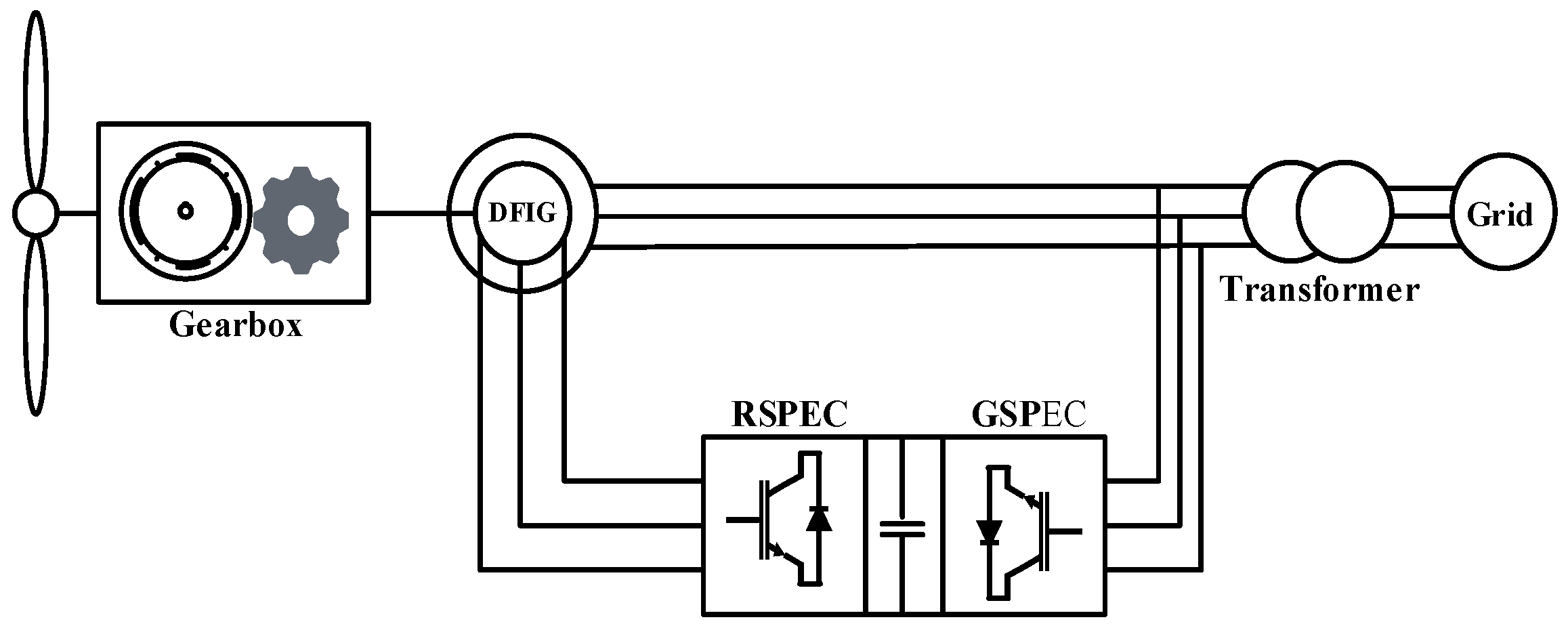
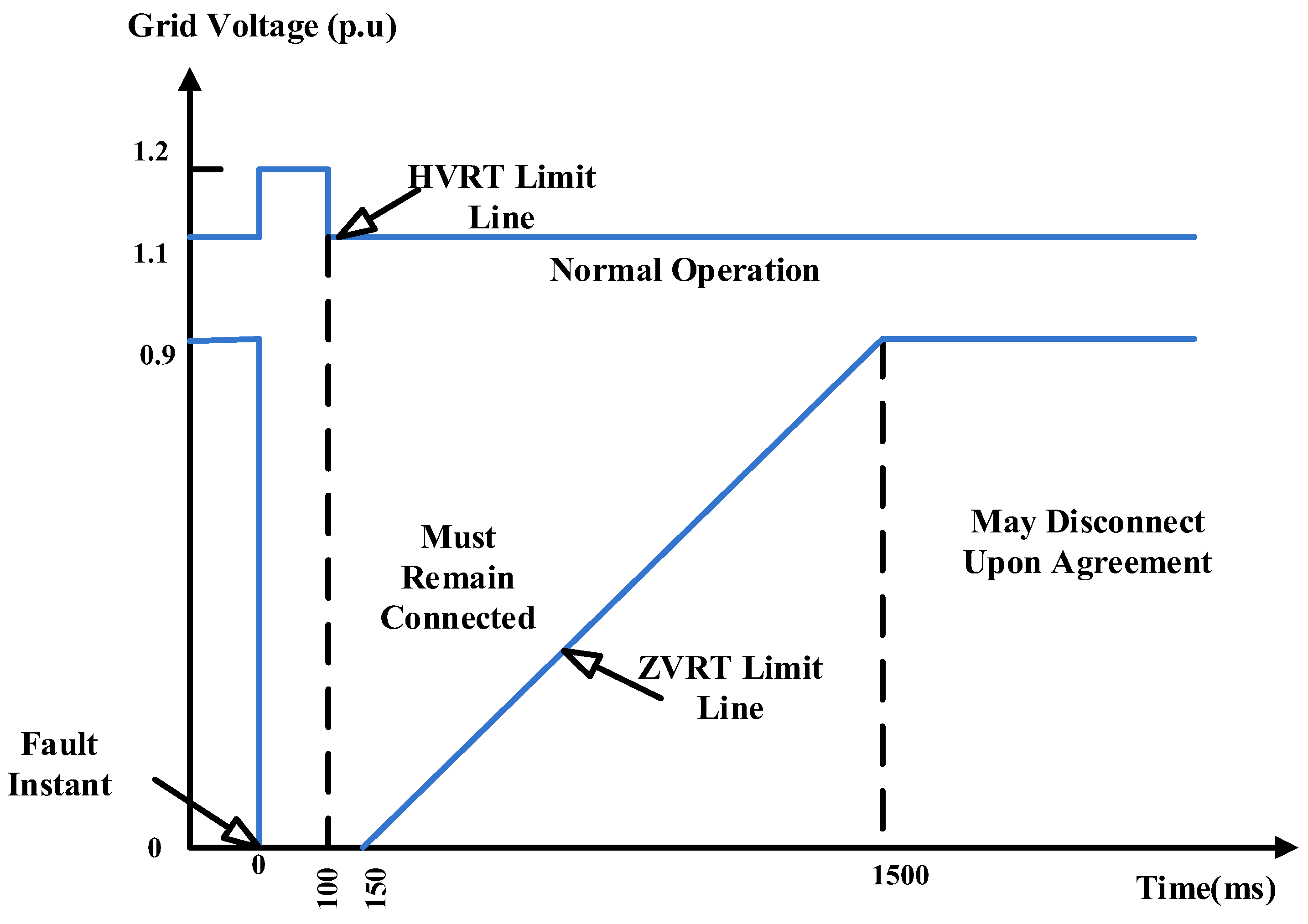
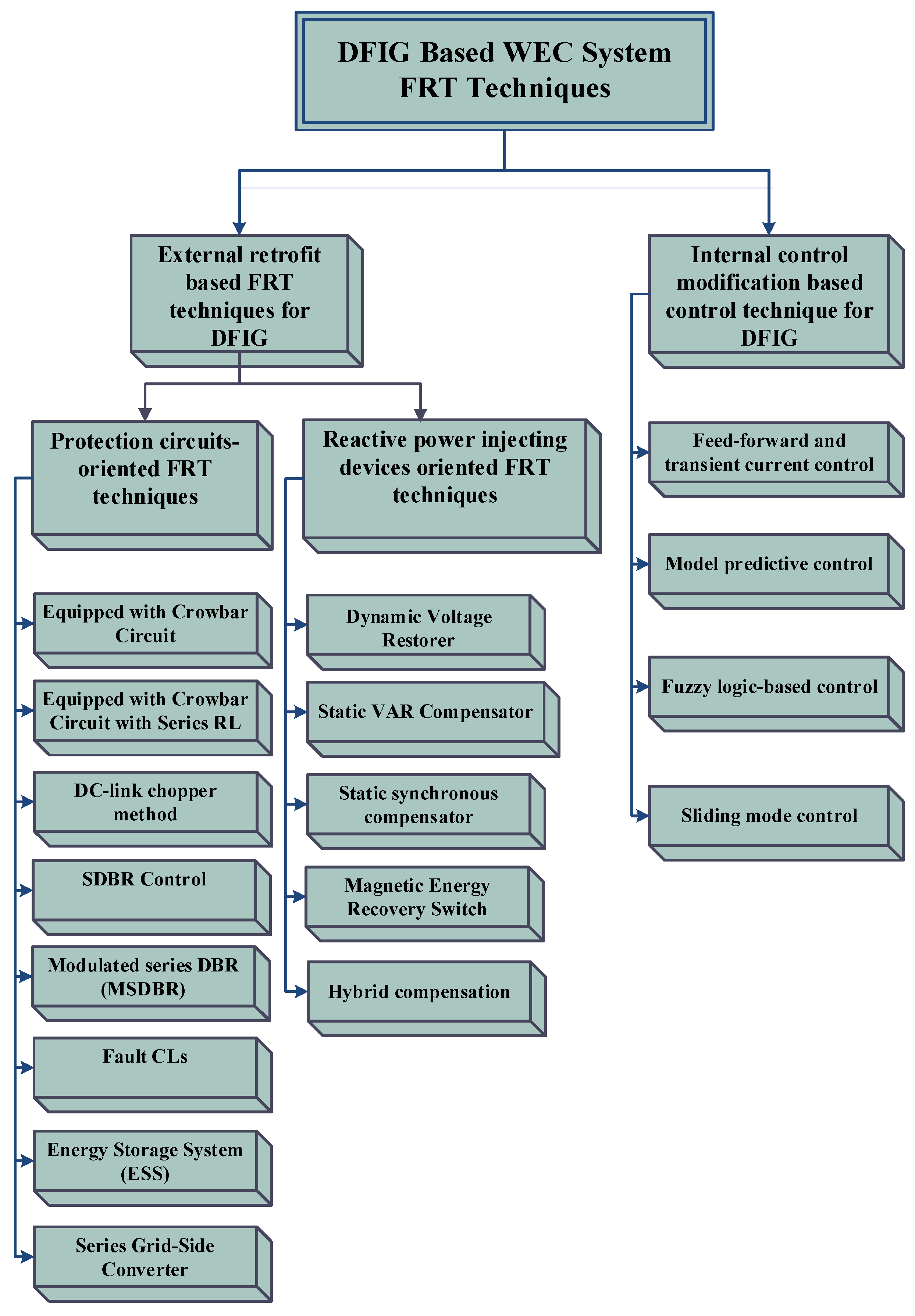
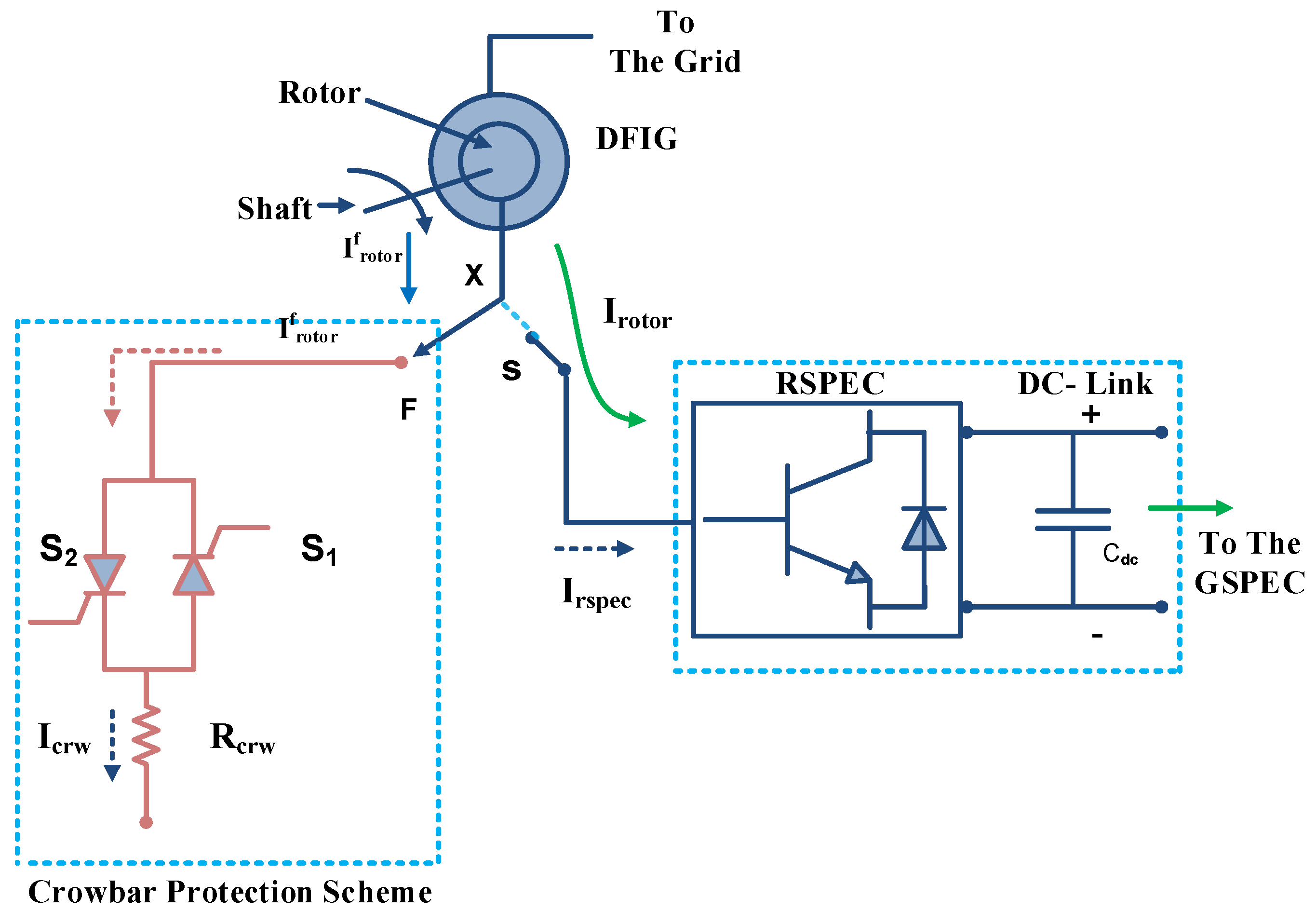
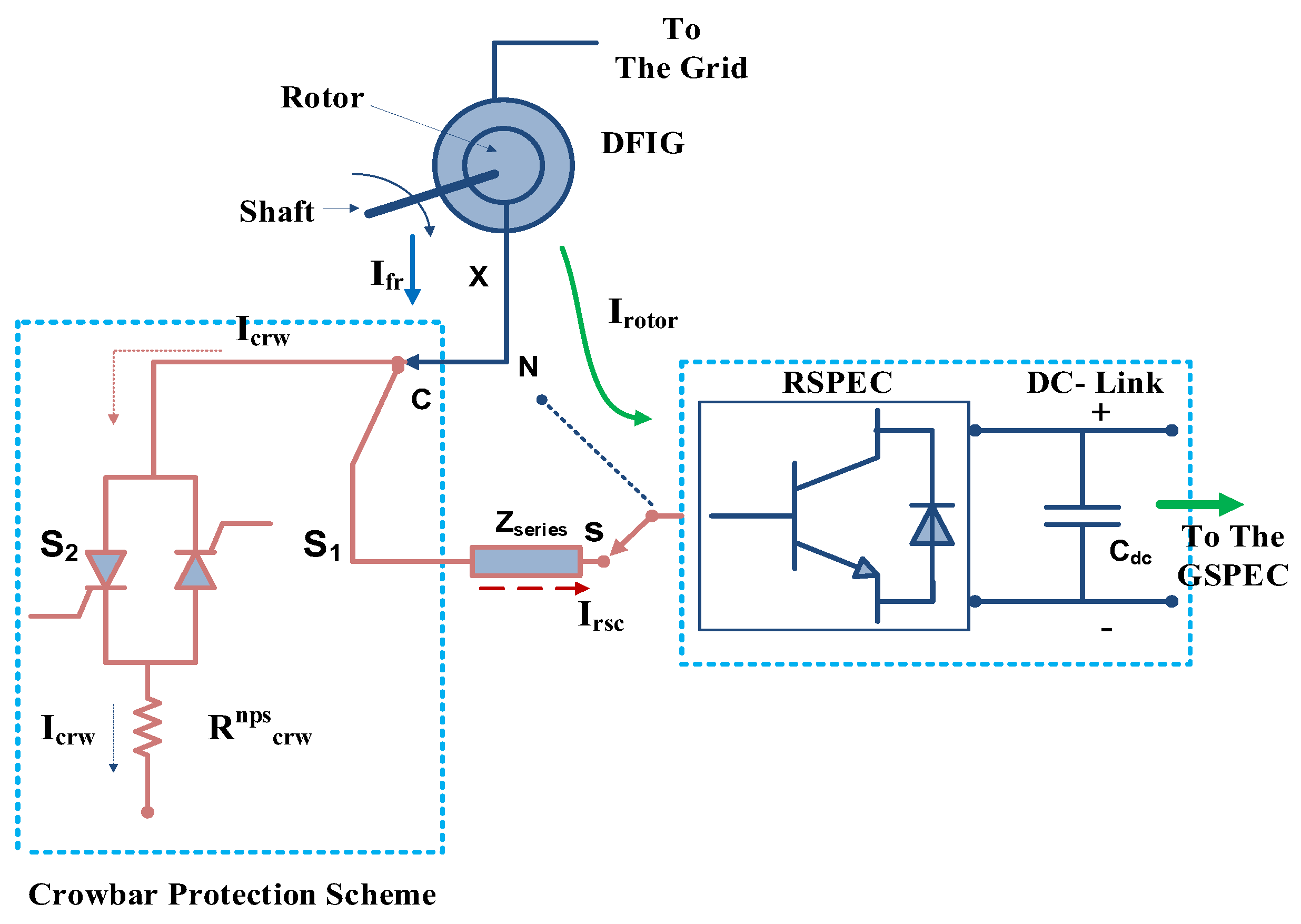

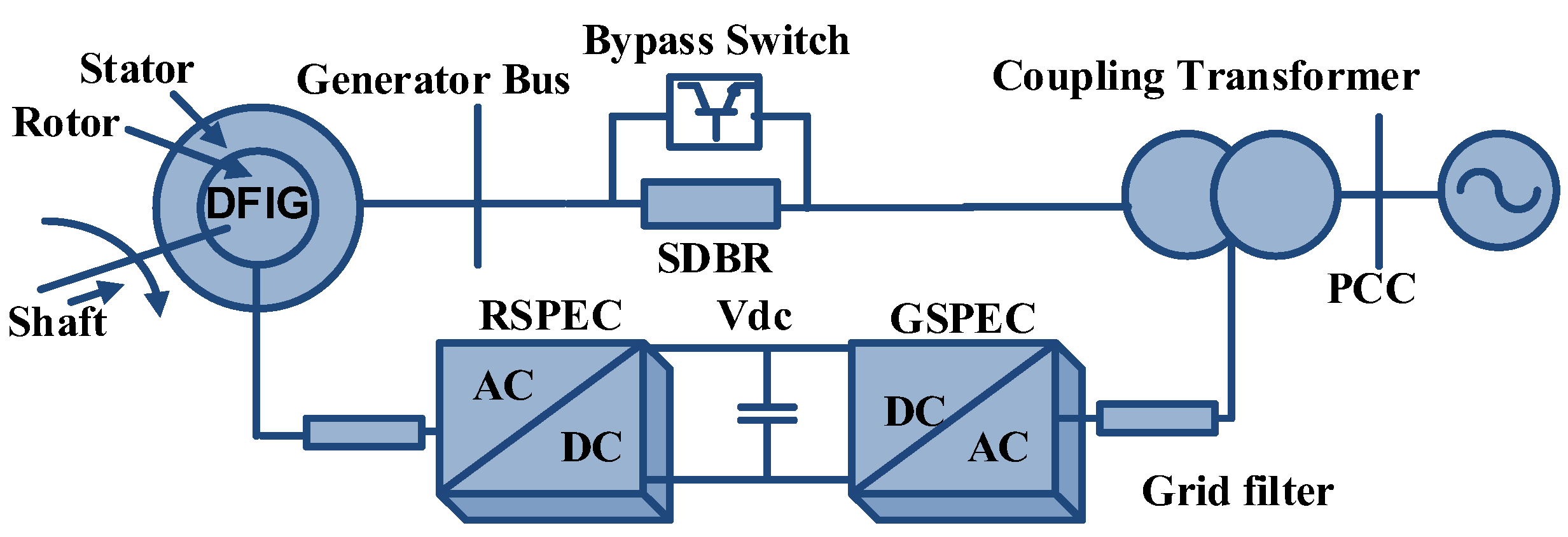

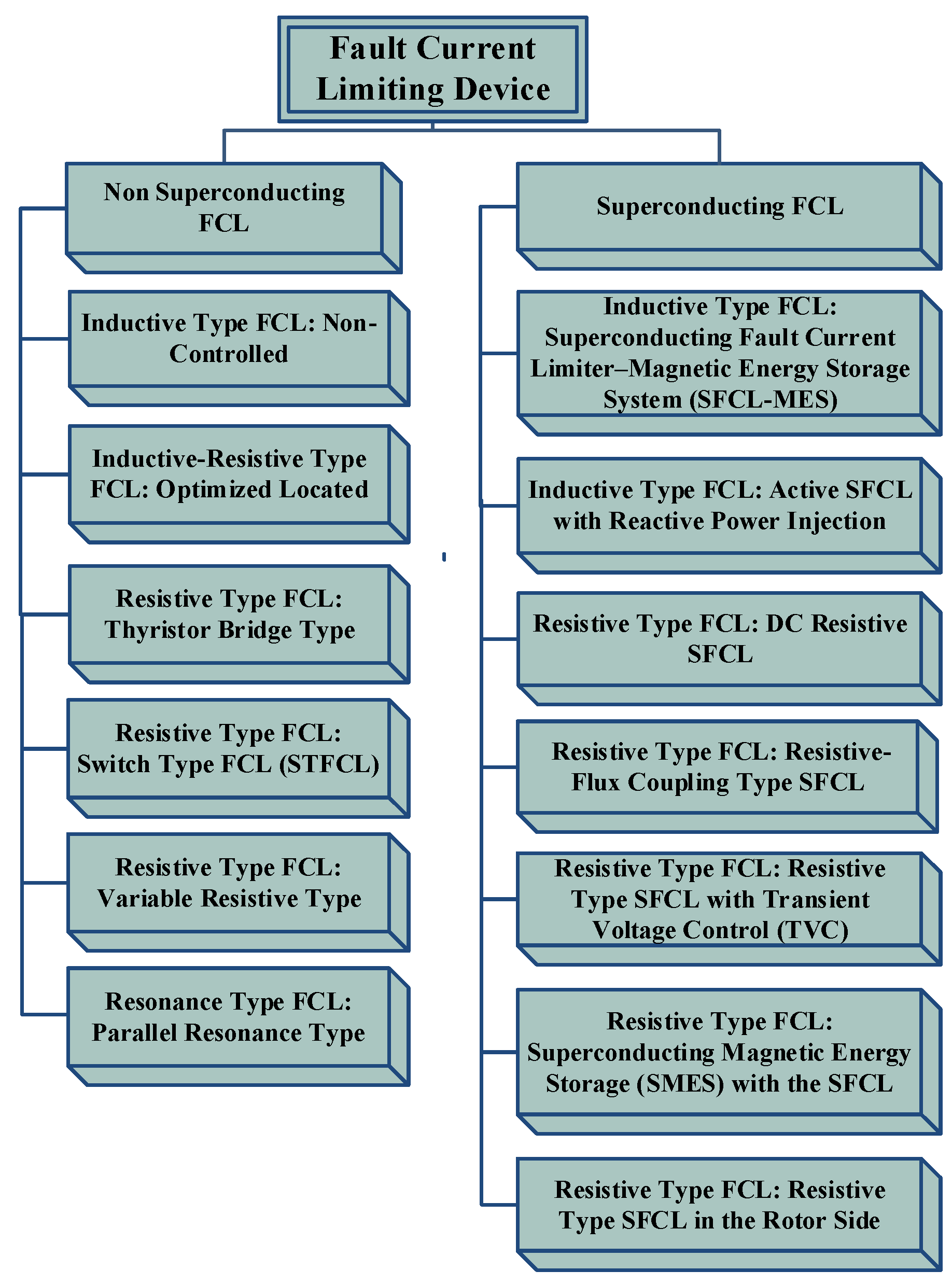

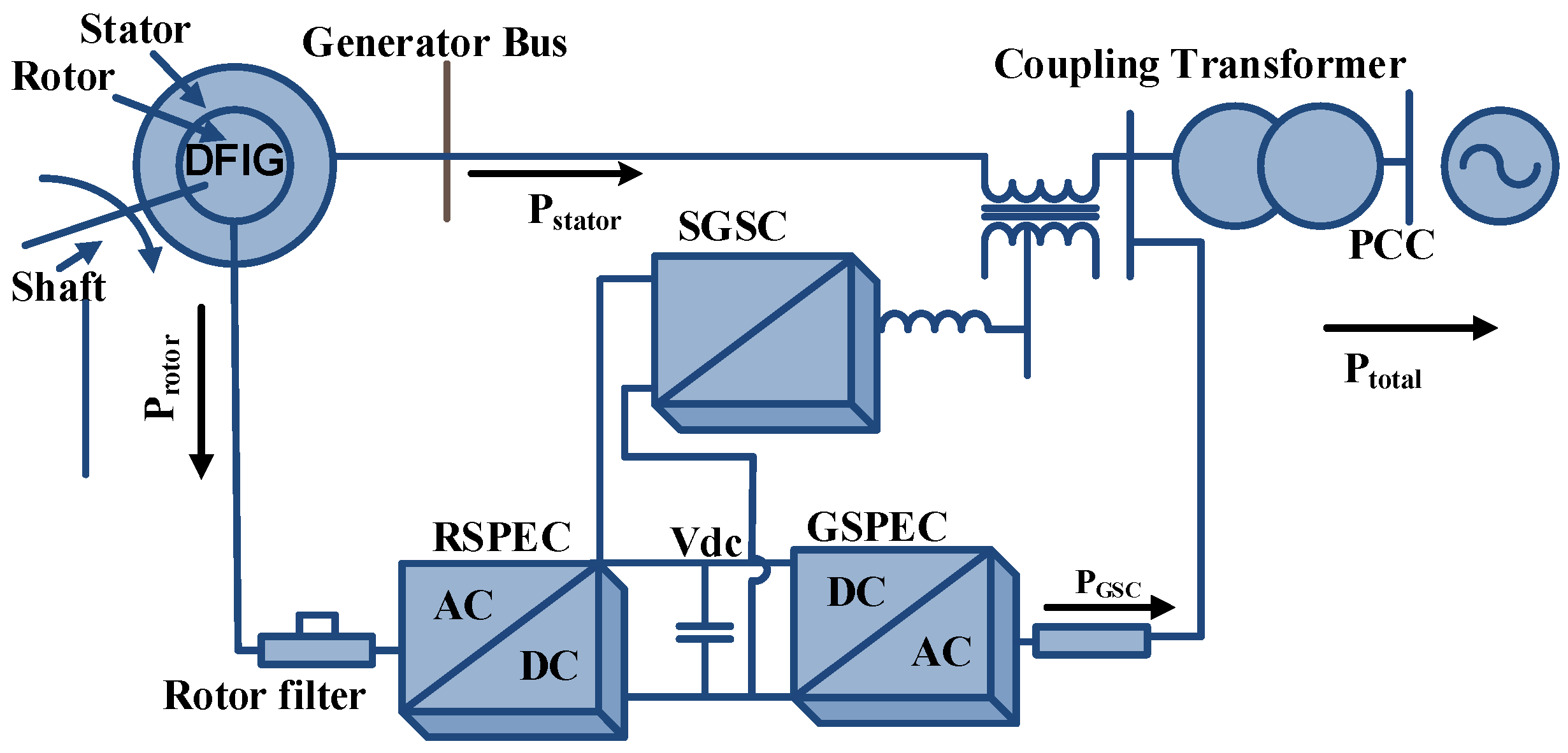
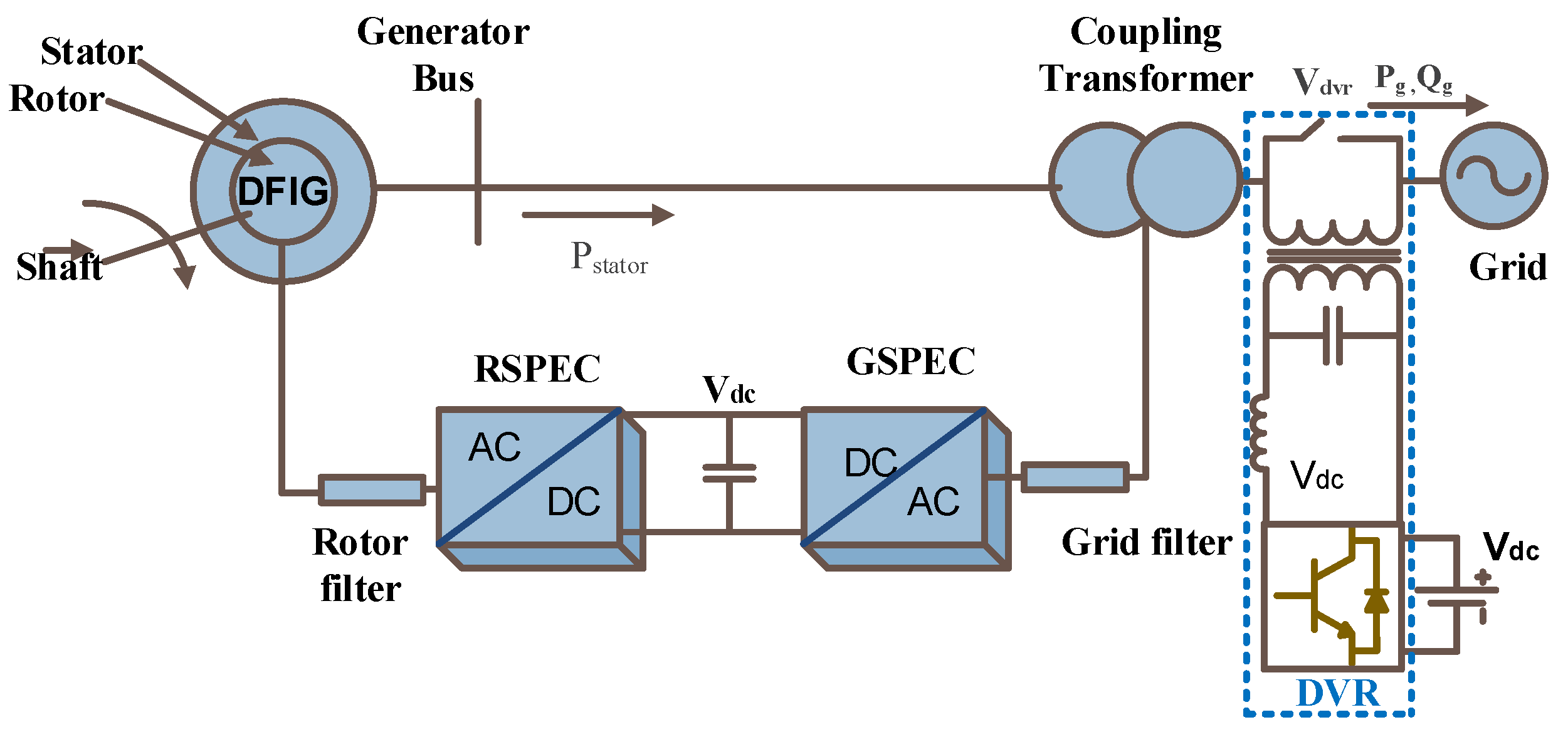
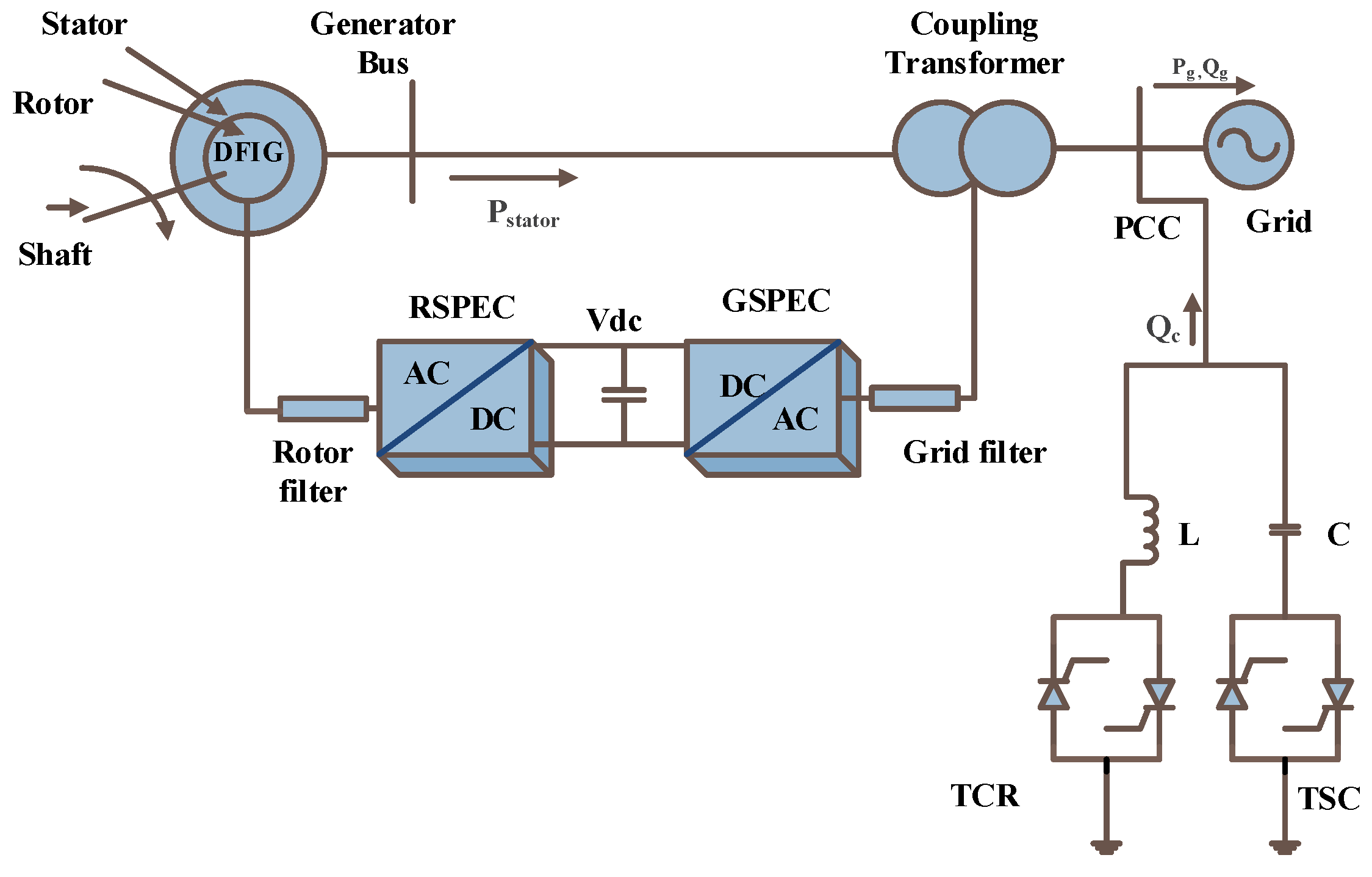
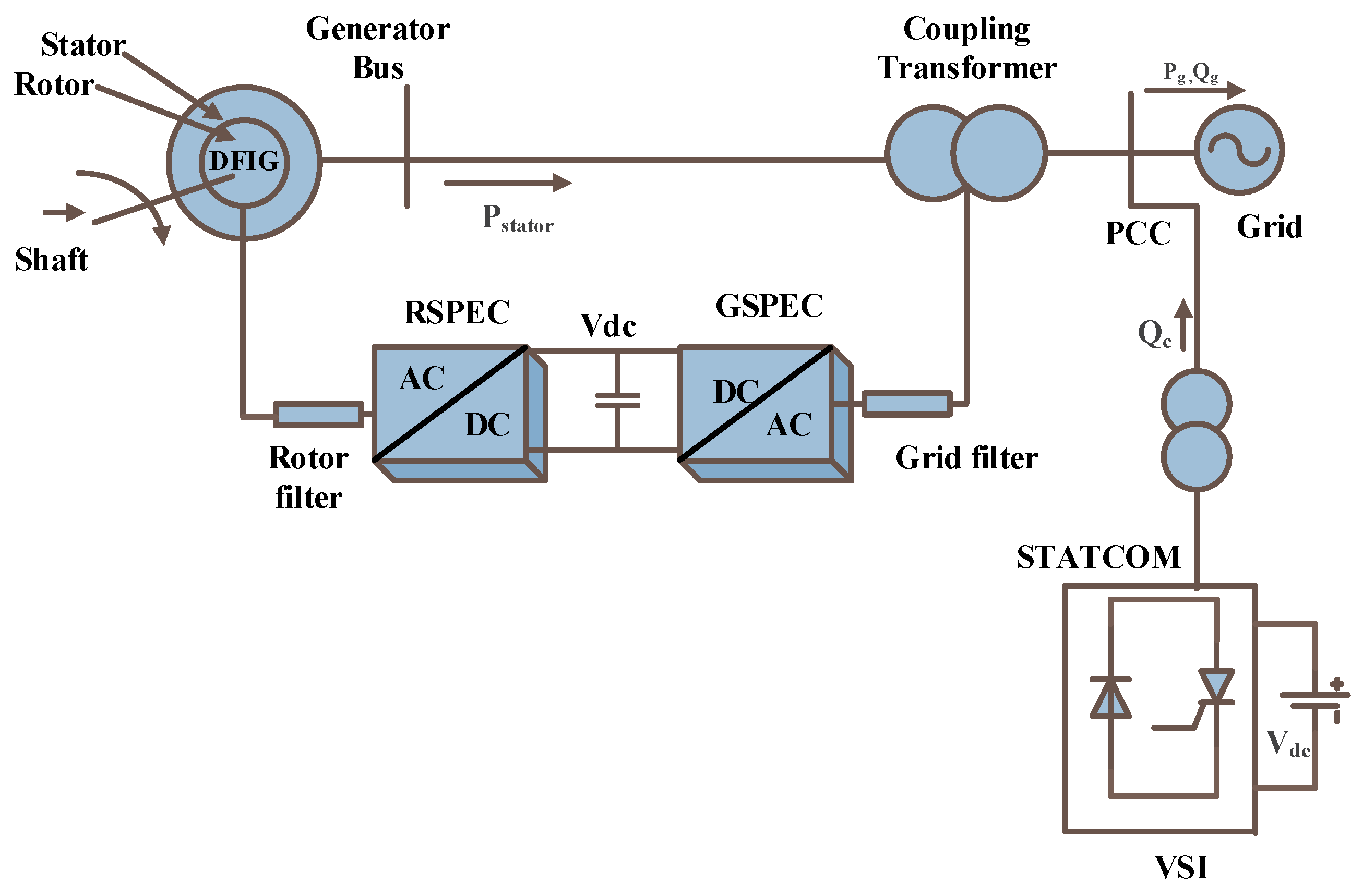

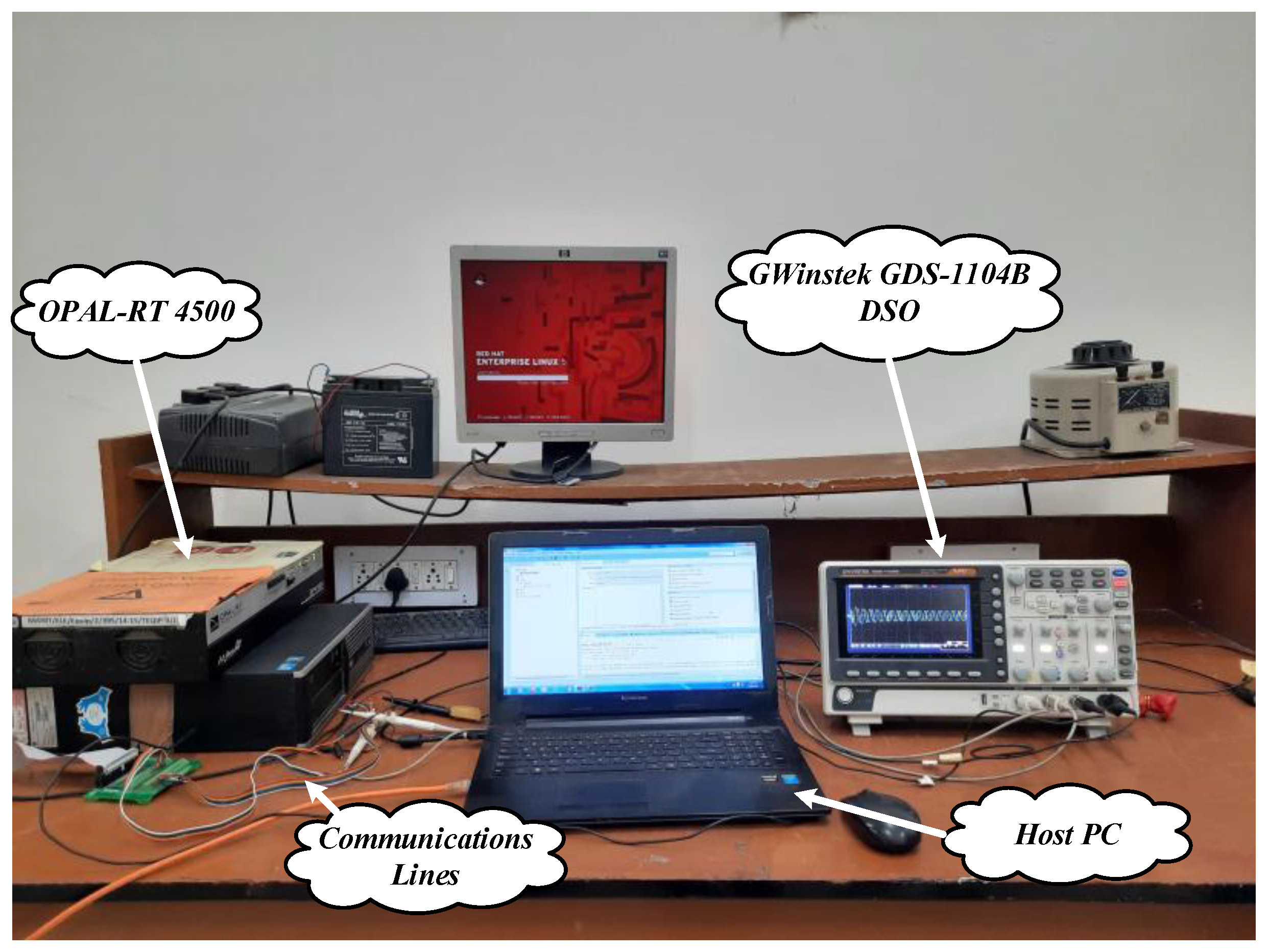
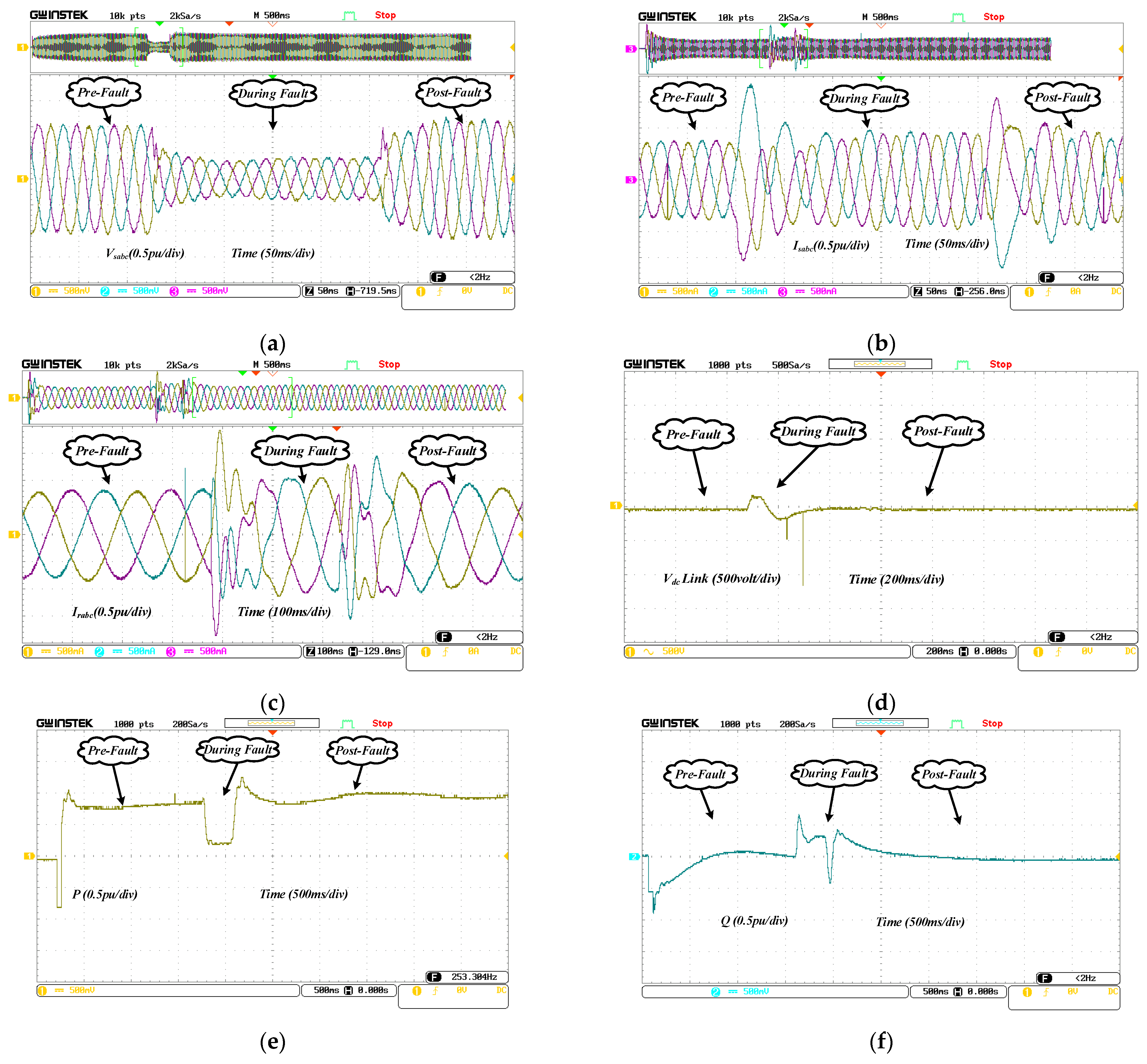
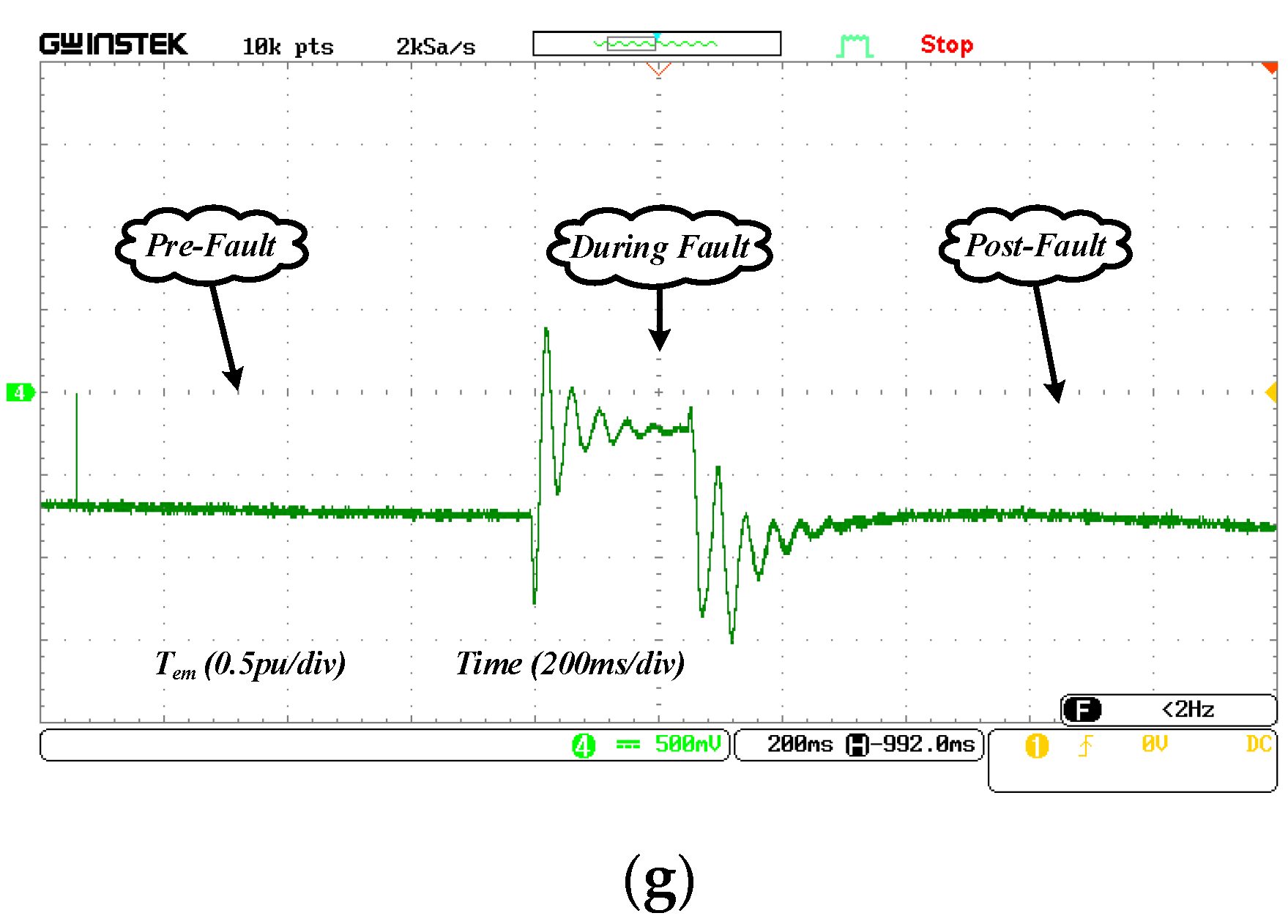
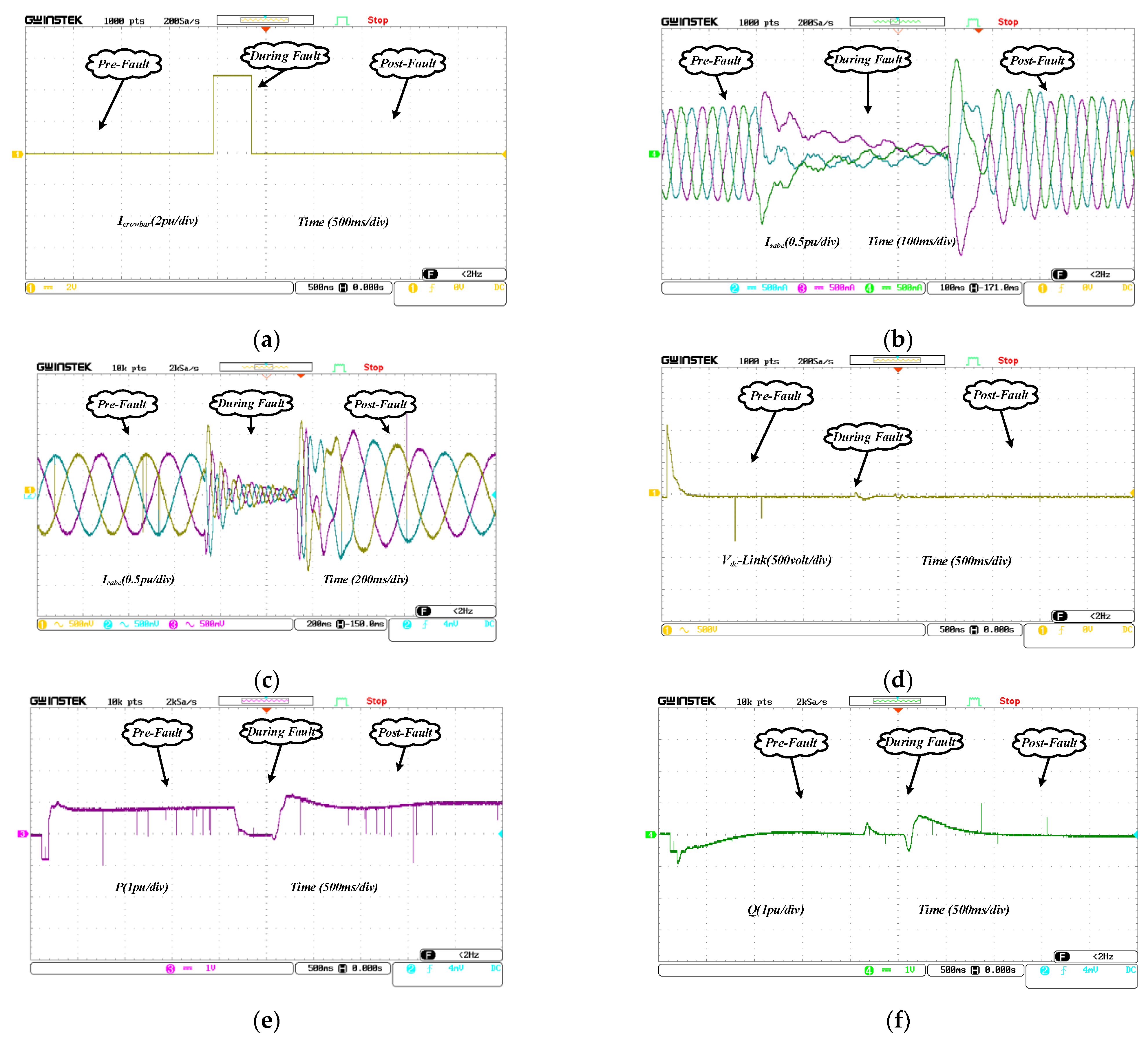
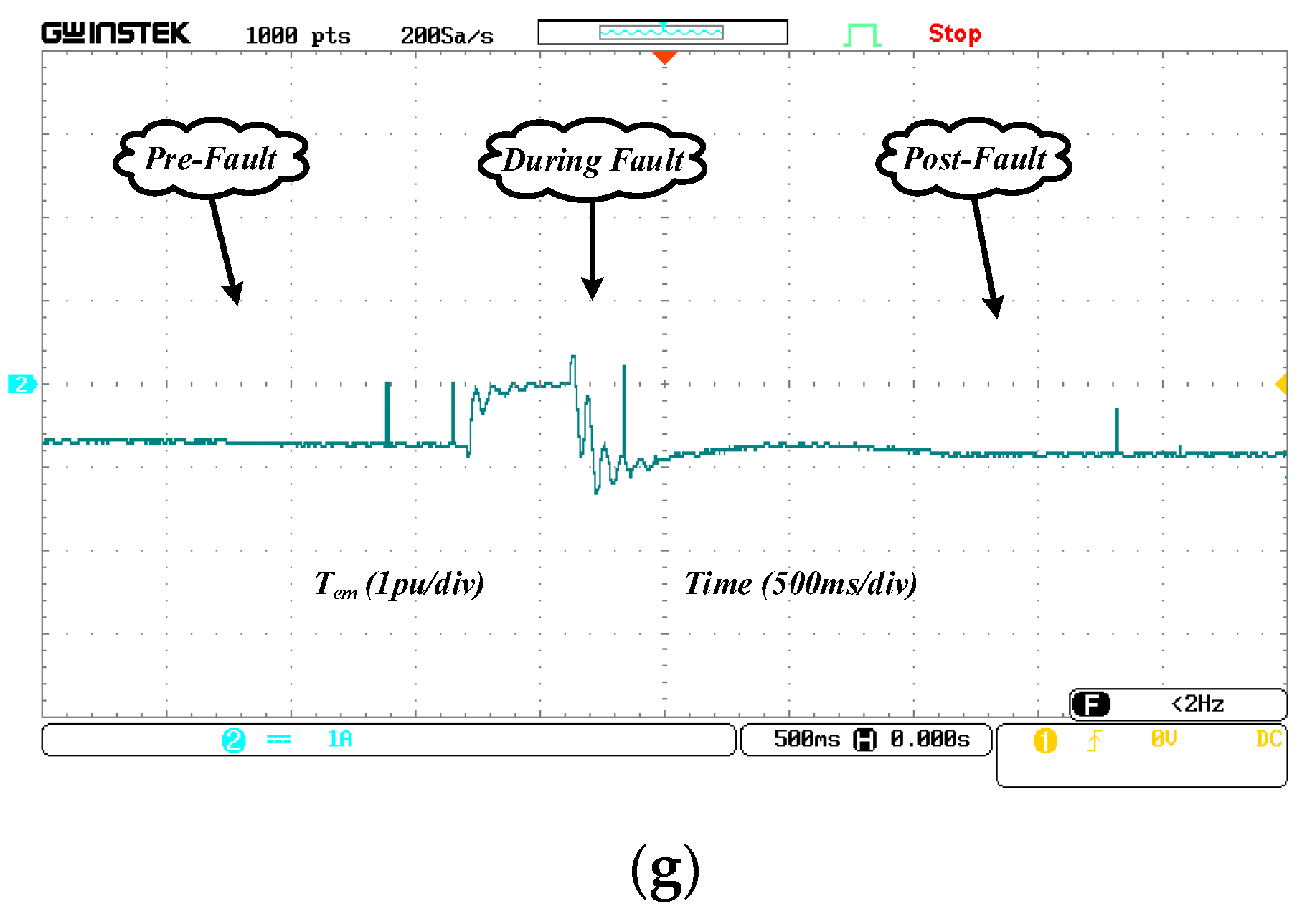
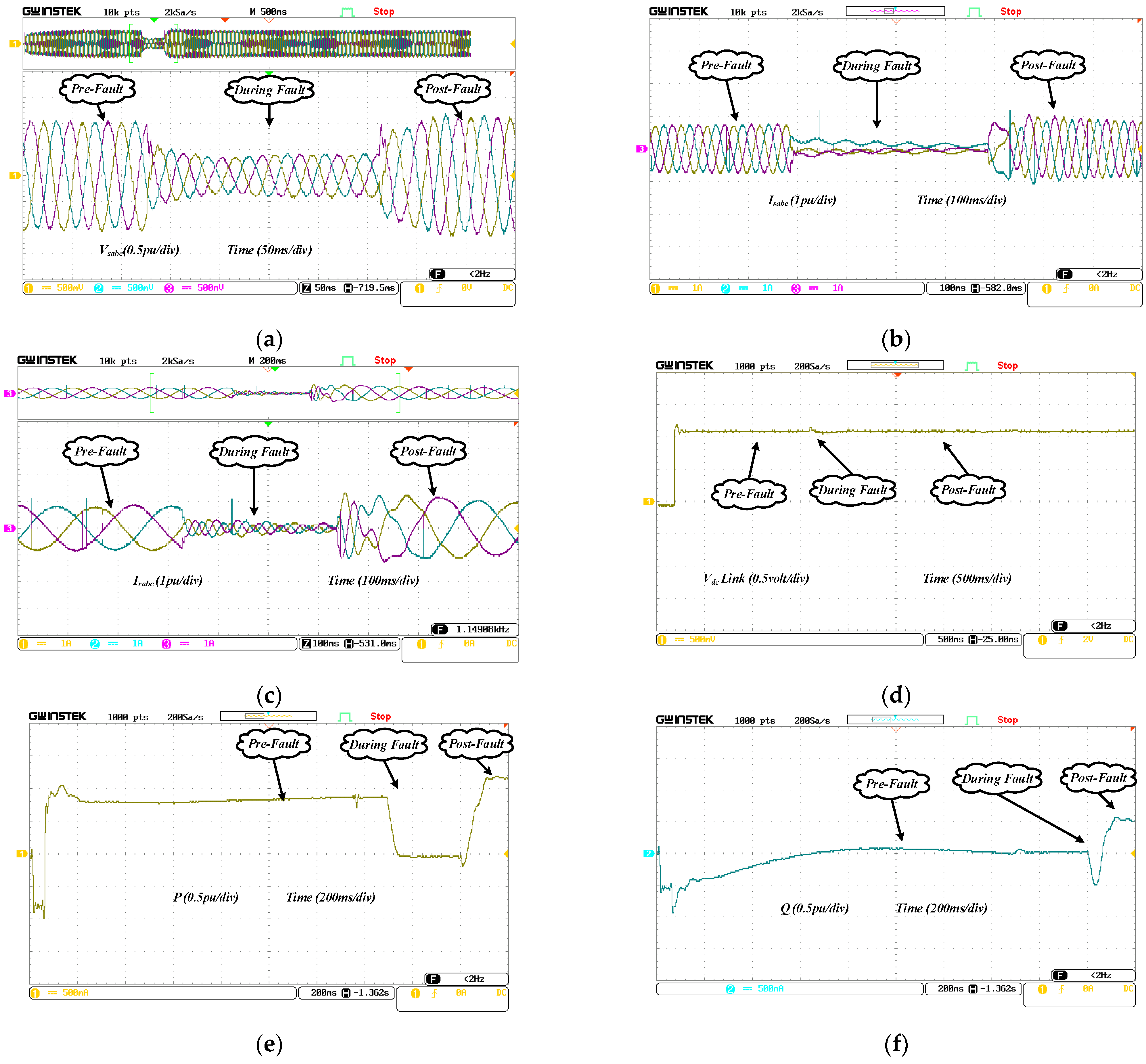
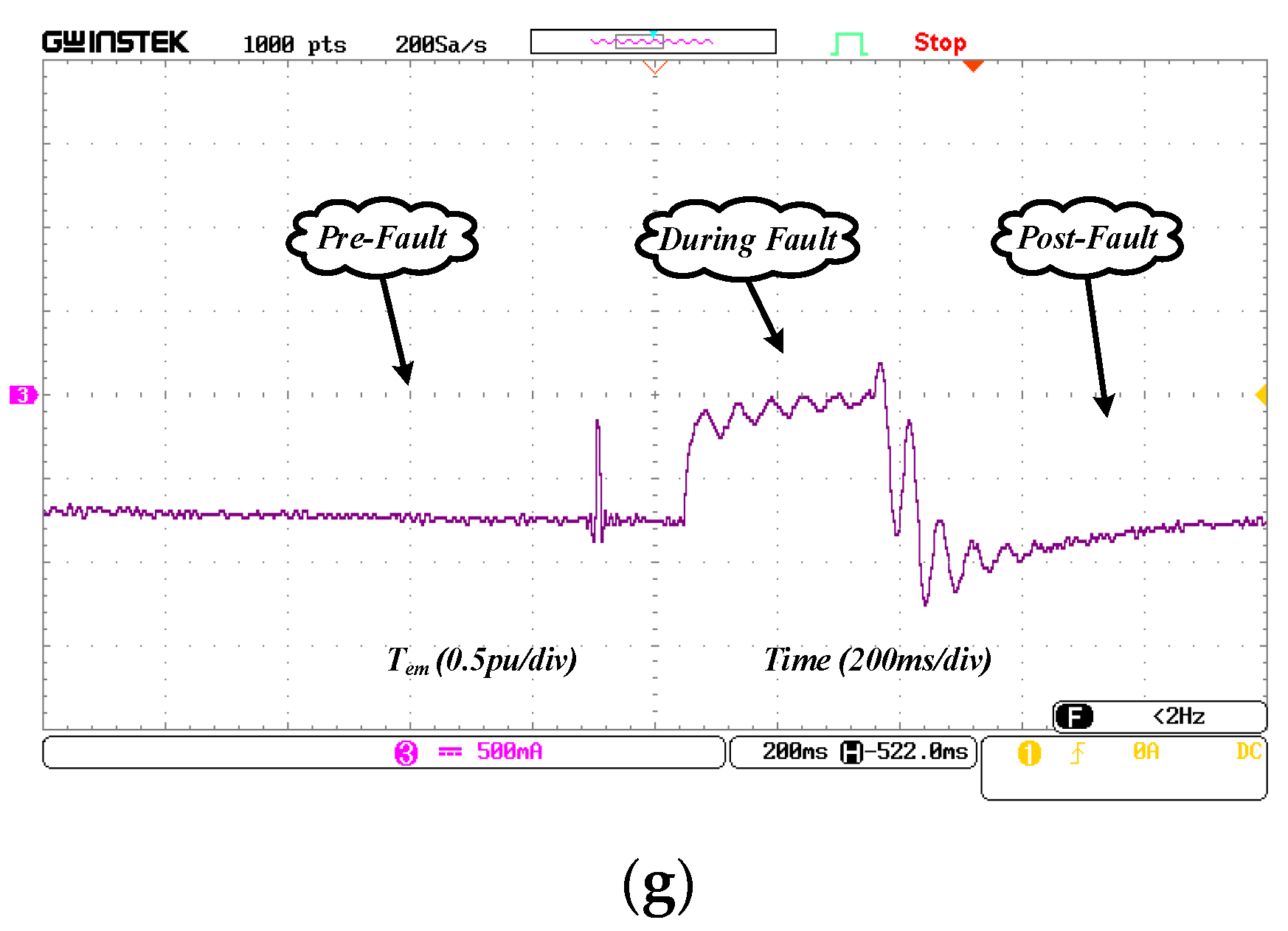
| Country | F (hz) | Frequency Limits | Max. Time Duration | LVRT During Fault/Post-Fault | HVRT During Fault | Power Factor | |||||
|---|---|---|---|---|---|---|---|---|---|---|---|
| Vmin. (p.u) | Tmax. (s) | Vmin. (p.u) | Tmax. (s) | Vmax. (p.u) | Tmax. (s) | Lag | Lead | ||||
| Australia | 50 | 47.5 < flim < 52.048 | Continuous | 0 | 0.10 | 0.7 | 2.0 | 1.3 | 0.06 | 0.95 | 0.95 |
| 49.0 < flim < 51.0 | 10 min | ||||||||||
| 48.0 < flim < 51.0 | 2 min | ||||||||||
| 47.5 < flim < 52.0 | 9 s | ||||||||||
| Germany | 50 | 49.0 < flim < 50.5 | Continuous | 0 | 0.15 | 0.85 | 1.0 | - | - | 0.9 | 0.95 |
| 48.5 < flim < 51.5 | 30 min | ||||||||||
| 47.5 < flim < 51.5 | 10 min | ||||||||||
| 46.5 < flim < 53.5 | 10 s | ||||||||||
| Denmark | 50 | 48.5 < flim < 51.0 | Continuous | 0.20 | 0.50 | 0.90 | 1.5 | 1.2 | 0.1 | 0.95 | 0.95 |
| 48.0 < flim < 51.0 | 25 min | ||||||||||
| 47.5 < flim < 52.0 | 5 min | ||||||||||
| 47.0 < flim < 52.0 | 10 s | ||||||||||
| India | 50 | 49.5< flim < 50.5 | Continuous | 0.15 | 0.30 | 0.85 | 3.0 | 1.3 | 0.2 | - | - |
| 47.5 < flim < 51.5 | WEC system remains connected | ||||||||||
| Canada | 60 | 59.4 < flim < 60.6 | Continuous | 0.0 | 0.15 | 0.85 | 1.0 | - | - | 0.90 | 0.95 |
| 58.5 < flim < 61.5 | 11 min | ||||||||||
| 57.5 < flim < 61.7 | 1.5 min | ||||||||||
| 56.5 < flim < 61.7 | 2 s | ||||||||||
| 55.5 < flim < 61.7 | 0.35 s | ||||||||||
| USA | 60 | 60.0 < flim < 59.5 | Continuous | 0.0 | 0.15 | 0.90 | 1.75 | 1.20 | 1 | 0.95 | 0.95 |
| 59.5 < flim < 59.3 | 10 min | ||||||||||
| 59.3 < flim < 58.7 | 10 s | ||||||||||
| UK | 50 | 47.5 < flim < 52.0 | Continuous | 0.15 | 0.14 | 0.80 | 1.21 | - | - | 0.95 | 0.95 |
| 47.0 < flim < 52.0 | 20 s | ||||||||||
| China | 50 | 49.5 < flim < 50.2 | Continuous | 0.2 | 0.625 | 0.9 | 2.0 | 1.3 | 0.5 | 0.95 | 0.95 |
| 47.15 < flim < 51.5 | 10 min | ||||||||||
| S. No | Technique Utilized | Benefits | Limitations |
|---|---|---|---|
| a. | Crowbar Technique [23,24,25,26] |
|
|
| b. | Crowbar with Series R–L [27] |
|
|
| c. | DC Link Chopper [8,30] |
|
|
| d. | SDBR [31,32] |
|
|
| e. | MSDBR [33] |
|
|
| f. | FCL SFCL [34,35] |
|
|
| g. | ESS [37,38,39,40] |
|
|
| h. | SGSC [41,42] |
|
|
| S. No | Method Utilized | Advantages | Disadvantages |
|---|---|---|---|
| a. | Dynamic Voltage Restorer (DVR) [43,44] |
|
|
| b. | Static VAR Compensator (SVC) [51,52] |
|
|
| c. | Static Synchronous Compensator (STATCOM) [53,54] |
|
|
| d. | Magnetic Energy Recovery Switch (MERS) [55,56] |
|
|
| e. | Hybrid Compensation (UPQC) [57] |
|
|
| S.No | Control | Advantages | Disadvantages |
|---|---|---|---|
| a. | FFTCC [59] |
|
|
| b. | MPC [60,61] |
|
|
| c. | Sliding mode control [67] |
|
|
| d. | Fuzzy-basedcontrol [70] |
|
|
| S.No | LVRT Strategy | Rotor Current | RSPEC Status | DC Link Voltage | Remark(S) |
|---|---|---|---|---|---|
| a. | Crowbar Circuit [24,84] (Figure 16) | Limited To < 2.0 | Blocked | Limits To < 1. 35p.U | Effective For Symmetrical Faults |
| b. | DC Link Chopper [8] | No Change | Maintained | Limits To < 1. 05p.U | Effective For All Types of Faults |
| c. | Crowbar Integrated with DC Link Chopper [84] | Reduced To < 2.0 | Blocked | Limits To < 1. 35p.u | Effective For All Types of Faults |
| d. | RSDBR Circuit (Figure 16) [85] | Reduced To < 1.59 | Maintained | Limits To < 1. 15p.u | Effective For All Types of Faults |
| e. | Crowbar Integrated with Series R–L [27] | Reduced To < 2.0 | Partially Maintained | Limits To < 1. 35p.u | Effective For All Types of Faults |
| f. | DVR [47] | Reduced To < 2.0 | Partially Maintained | Limits To < 1. 25p.u | Effective For All Types of Faults |
Publisher’s Note: MDPI stays neutral with regard to jurisdictional claims in published maps and institutional affiliations. |
© 2022 by the authors. Licensee MDPI, Basel, Switzerland. This article is an open access article distributed under the terms and conditions of the Creative Commons Attribution (CC BY) license (https://creativecommons.org/licenses/by/4.0/).
Share and Cite
Ansari, A.A.; Dyanamina, G. Fault Ride-Through Operation Analysis of Doubly Fed Induction Generator-Based Wind Energy Conversion Systems: A Comparative Review. Energies 2022, 15, 8026. https://doi.org/10.3390/en15218026
Ansari AA, Dyanamina G. Fault Ride-Through Operation Analysis of Doubly Fed Induction Generator-Based Wind Energy Conversion Systems: A Comparative Review. Energies. 2022; 15(21):8026. https://doi.org/10.3390/en15218026
Chicago/Turabian StyleAnsari, Aftab Ahmed, and Giribabu Dyanamina. 2022. "Fault Ride-Through Operation Analysis of Doubly Fed Induction Generator-Based Wind Energy Conversion Systems: A Comparative Review" Energies 15, no. 21: 8026. https://doi.org/10.3390/en15218026
APA StyleAnsari, A. A., & Dyanamina, G. (2022). Fault Ride-Through Operation Analysis of Doubly Fed Induction Generator-Based Wind Energy Conversion Systems: A Comparative Review. Energies, 15(21), 8026. https://doi.org/10.3390/en15218026






